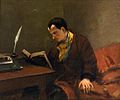Portal:Poetry
Welcome to the Poetry Portal


Poetry (from the Greek word poiesis, "making") is a form of literary art that uses aesthetic and often rhythmic qualities of language to evoke meanings in addition to, or in place of, literal or surface-level meanings. Any particular instance of poetry is called a poem and is written by a poet. Poets use a variety of techniques called poetic devices, such as assonance, alliteration, consonance, euphony and cacophony, onomatopoeia, rhythm (via metre), rhyme schemes (patterns in the type and placement of a phoneme group) and sound symbolism, to produce musical or other artistic effects. They also frequently organize these devices intos, which may be strict or loose, conventional or invented by the poet. Poetic structures vary dramatically by language and cultural convention, but they often rely on rhythmic metre: patterns of syllable stress or syllable (or mora) weight. They may also use repeating patterns of phonemes, phoneme groups, tones, words, or entire phrases. Poetic structures may even be semantic (e.g. the volta required in a Petrachan sonnet).
Most written poems are formatted in verse: a series or stack of lines on a page, which follow the poetic structure. For this reason, verse has also become a synonym (a metonym) for poetry. Some poetry types are unique to particular cultures and genres and respond to characteristics of the language in which the poet writes. Readers accustomed to identifying poetry with Dante, Goethe, Mickiewicz, or Rumi may think of it as written in lines based on rhyme and regular meter. There are, however, traditions, such as Biblical poetry and alliterative verse, that use other means to create rhythm and euphony. Other traditions, such as Somali poetry, rely on complex systems of alliteration and metre independent of writing and have been described as structurally comparable to ancient Greek and medieval European oral verse. Much modern poetry reflects a critique of poetic tradition, testing the principle of euphony itself or altogether forgoing rhyme or set rhythm. In first-person poems, the lyrics are spoken by an "I", a character who may be termed the speaker, distinct from the poet (the author). Thus if, for example, a poem asserts, "I killed my enemy in Reno", it is the speaker, not the poet, who is the killer (unless this "confession" is a form of metaphor which needs to be considered in closer context – via close reading).
Poetry uses forms and conventions to suggest differential interpretations of words, or to evoke emotive responses. The use of ambiguity, symbolism, irony, and other stylistic elements of poetic diction often leaves a poem open to multiple interpretations. Similarly, figures of speech such as metaphor, simile, and metonymy establish a resonance between otherwise disparate images—a layering of meanings, forming connections previously not perceived. Kindred forms of resonance may exist, between individual verses, in their patterns of rhyme or rhythm. (Full article...)
Selected article

Verses in the Ramayana are written in a 32-syllable meter called anuṣṭubh. The Ramayana was an important influence on later Sanskrit poetry and Hindu life and culture. Like the Mahabharata, the Ramayana is not just a story: it presents the teachings of ancient Hindu sages (Vedas) in narrative allegory, interspersing philosophical and devotional elements. The characters Rama, Sita, Lakshman, Bharata, Hanuman, and Ravana are all fundamental to the cultural consciousness of India, Nepal, and many south-east Asian countries such as Thailand and Indonesia. (Full article...)
Selected image

Poetry WikiProject

Selected biography

Born in Huntington on Long Island, Whitman worked as a journalist, a teacher, a government clerk, and—in addition to publishing his poetry—was a volunteer nurse during the American Civil War. Early in his career, he also produced a temperance novel, Franklin Evans (1842). Whitman's major work, Leaves of Grass, was first published in 1855 with his own money. The work was an attempt at reaching out to the common person with an American epic. He continued expanding and revising it until his death in 1892. After a stroke towards the end of his life, he moved to Camden, New Jersey, where his health further declined. He died at age 72 and his funeral became a public spectacle. (Full article...)
Did you know (auto-generated) -

- ... that Daniel Hermann wrote poems on the inclusion of a lizard and a frog in a piece of amber, the eagle in the coat of arms of Poland, and a child suffering from Fraser syndrome?
- ... that Mihai Eminescu's poem "Out of All the Masts", which Eminescu himself never intended to publish, has won posthumous praise as a "perfect combination of words"?
- ... that Michael Huber's translation of Salomon Gessner's works into French made Gessner the best-known German-language poet in Europe before Goethe?
- ... that Benjamin Britten composed Canticle I: My beloved is mine and I am his for the tenor voice of Peter Pears, using poetry from A Divine Rapture by Francis Quarles?
- ... that Liang Sishun published an anthology of Chinese poetry in 1908, when she was about fifteen years old?
- ... that Ephraim E. Lisitzky wrote an epic poem in Hebrew based on Native American legends?
Selected poem
| Still from the night ... by Nima Yooshij |
|---|
|
Still from the night, a breeze remains, singing in the night sky |
Related portals
Topics
Recognized content
Categories
Associated Wikimedia
The following Wikimedia Foundation sister projects provide more on this subject:
-
Commons
Free media repository -
Wikibooks
Free textbooks and manuals -
Wikidata
Free knowledge base -
Wikinews
Free-content news -
Wikiquote
Collection of quotations -
Wikisource
Free-content library -
Wikiversity
Free learning tools -
Wiktionary
Dictionary and thesaurus











